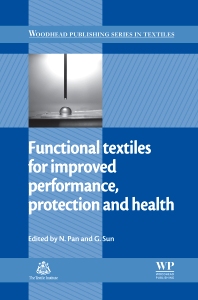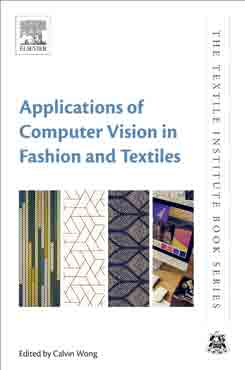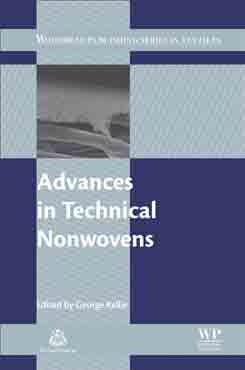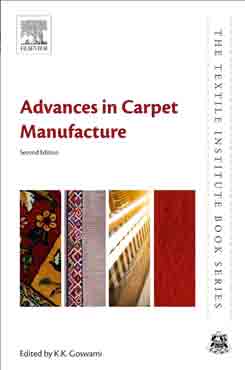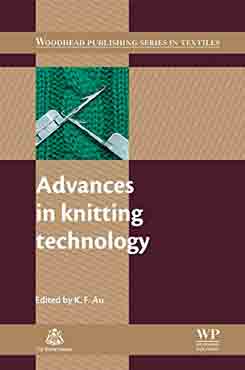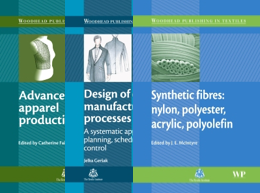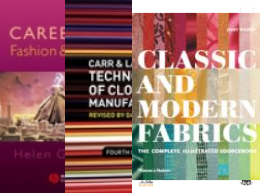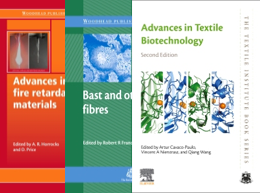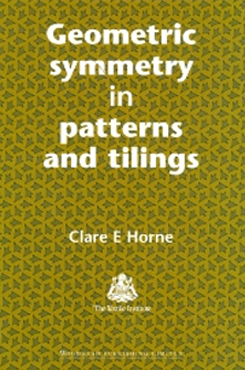Description
The textile industry is increasingly based on ongoing innovation and development of higher performance products, and the field of functional textiles is no exception. This book explores the development of textiles with a wide range of functions, with the aim of improving the performance of the product in terms of the protection and health benefits that it can offer.The book is split into two parts. Part one focuses on functional textiles for improved performance and protection, with chapters reviewing antistatic, flame retardant and infrared functional textiles, among many others.
Chapters in part two examine the uses of functional textiles in a medical context, including superhydrophobic materials, antibacterial textiles and insect-repellent materials.With its distinguished editors and contributions from some of the world’s leading authorities, Functional textiles for improved performance, protection and health is invaluable for textile scientists, technologists and engineers as well as those designing and manufacturing textiles. It is also a suitable reference for the academic sector.
Key Features
- Examines the use of functional textiles in a medical context, including superhydrophobic materials, antibacterial textiles and insect-repellent materials
- Topics range from textile chemicals and their interaction with skin to novel pesticide protective clothing
- Considers anti-ultraviolet protection of clothing and flame retardant textiles
Readership
Table of Contents
- Part I: Functional textiles and clothing for improved performance and protection
Chapter 1: Improved textile functionality through surface modifications
Abstract:
1.1 Introduction
1.2 Types of surface modification
1.3 Physical and chemical characterization of surface modifications
1.4 Applications for functional textiles
1.5 Future trends
Chapter 2: Antistatic and conductive textiles
Abstract:
2.1 Introduction
2.2 Principles of antistatic and conductive textiles
2.3 The role of antistatic and conductive textiles
2.4 Types of antistatic and conductive textiles
2.5 Evaluation of antistatic and conductive textiles
2.6 Future trends
2.7 Sources of further information and advice
Chapter 3: Ultraviolet protection of clothing
Abstract:
3.1 Introduction
3.2 In vitro and in vivo testing of the UV protection factor
3.3 Standards for sun-protective clothing
3.4 Type and construction of fabric
3.5 Fabric color, dyes and UV absorbers
3.6 Effects of environment and fabric use on UV protection factor
3.7 Conclusions and outlook
Chapter 4: 3D body imaging and fit for functional textiles
Abstract:
4.1 Introduction
4.2 3D body imaging – stereovision
4.3 Surface modeling
4.4 Virtual dressing
4.5 Sewability and fit assessment
4.6 Future trends
4.7 Acknowledgement
Chapter 5: Flame retardant functional textiles
Abstract:
5.1 Introduction
5.2 Factors affecting flammability and thermal behavior of textile fibers and fabrics
5.3 Types, chemistry and mode of action of flame retardant additives
5.4 Flame retardation of textile materials
5.5 Environmental issues related to flame retardants
5.6 Test standards for flame retardant textiles
Chapter 6: Functional shape memory textiles
Abstract:
6.1 Introduction
6.2 Shape memory mechanisms of SMAs
6.3 Applications of SMAs in textiles
6.4 Shape memory mechanisms of SMPs
6.5 Applications of SMPs in textiles
6.6 Future trends
Chapter 7: Thermo-regulating textiles with phase-change materials
Abstract:
7.1 Introduction
7.2 Concept of thermal comfort and clothing for cold environments
7.3 How PCMs work
7.4 Thermo-physiological comfort for PCM incorporated textiles
7.5 Different types of PCMs
7.6 Incorporation of PCM in textile structure
7.7 Applications of PCM incorporated textiles
7.8 Challenges of PCM in textiles
7.9 Acknowledgement
Chapter 8: Infrared functional textiles
Abstract:
8.1 Introduction and overview
8.2 Principles of IR
8.3 FIR therapy
8.4 The role of FIR in relation to functional textiles
8.5 Applications
8.6 Benefits and limitations
8.7 Conclusions and future trends
8.9 Acknowledgements
Chapter 9: Functional smart textiles using stimuli-sensitive polymers
Abstract:
9.1 Introduction
9.2 Stimuli-sensitive polymers
9.3 Drawbacks and limitations of current SSP/hydrogels
9.4 Smart functional textiles
9.5 Conclusions
Chapter 10: Development and design of performance swimwear
Abstract:
10.1 Introduction
10.2 Development of performance swimwear
10.3 Biomechanics of swimming
10.4 Effect of innovative swimwear on swimming performance
10.5 Future trends in innovative performance swimwear
10.6 Sources of further information and advice
10.7 Acknowledgements
Chapter 11: Key elements of protection for military textiles
Abstract:
11.1 Introduction
11.2 Camouflage
11.3 Ballistics
11.4 Toxic chemicals
11.5 Conclusions
Chapter 12: Developments in clothing protection technology
Abstract:
12.1 Introduction
12.2 Key issues of protective clothing
12.3 Developments in clothing protection
12.4 Future trends
Part II: Functional textiles for improved medical and health purposes
Chapter 13: New developments in functional medical textiles and their mechanism of action
Abstract:
13.1 Introduction
13.2 Extracorporeals and implantables
13.3 Structure and composition: role of functionality in implantables
13.4 The role of biomolecules in conferring bioactive function
13.5 Non-implantables: wound dressings, pressure ulcers, hemorrhage control
Chapter 14: Improving superhydrophobic coatings for textiles through chemical modifications
Abstract:
14.1 Introduction
14.2 Key principles of superhydrophobic textiles
14.3 Chemical modifications for fabricating rough surfaces on textiles
14.4 Hydrophobization for lowering the surface energy of roughened textiles
14.5 Nanoscaled coating of materials with low surface energy
14.6 Applications
14.7 Future trends
Chapter 15: Improving superhydrophobic textile materials
Abstract:
15.1 Introduction
15.2 Physical modification for superhydrophobic textiles
15.3 Applications
15.4 Future trends
Chapter 16: Antibacterial textile materials for medical applications
Abstract:
16.1 Introduction
16.2 Principles of antimicrobial textiles
16.3 The development of antibacterial textiles
16.4 Performance of antibacterial textiles
16.5 New antimicrobial technologies
16.6 Applications of antimicrobial textiles
16.7 Future trends
16.8 Acknowledgments
Chapter 17: Antibacterial colorants for textiles
Abstract:
17.1 Introduction
17.2 Synthetic antibacterial colorants
17.3 Natural antimicrobial colorants
17.4 Antimicrobial colorants from micro-organisms
17.5 Photo-activated antimicrobial colorants
Chapter 18: Pyrethroid-laden textiles for protection from biting insects
Abstract:
18.1 Introduction
18.2 Key issues of insecticide-laden textiles
18.3 Factory-produced LLINs and textiles for protection from biting insects
18.4 In situ treatment of bednets and other textiles to enable protection from biting insects
18.5 Future trends
18.6 Sources of further information and advice
Chapter 19: Improving the functionality of clothing through novel pesticide protection
Abstract:
19.1 Introduction to human exposure
19.2 Mechanisms for chemical protection
19.3 Development of novel pesticide-protective clothing
Chapter 20: Biomechanics in skin/clothing interactions
Abstract:
20.1 Introduction
20.2 An explicit finite element model of skin/sleeve interactions during arm rotation
20.3 Skin friction blistering: computer model
Chapter 21: Transdermal permeation of textile dyes and chemicals
Abstract:
21.1 Introduction
21.2 Key issues of textile dyes/chemicals and skin irritations
21.3 An in vitro study of transdermal drug permeation
21.4 Stochastic modeling for transdermal drug delivery
21.5 Conclusion
Index
